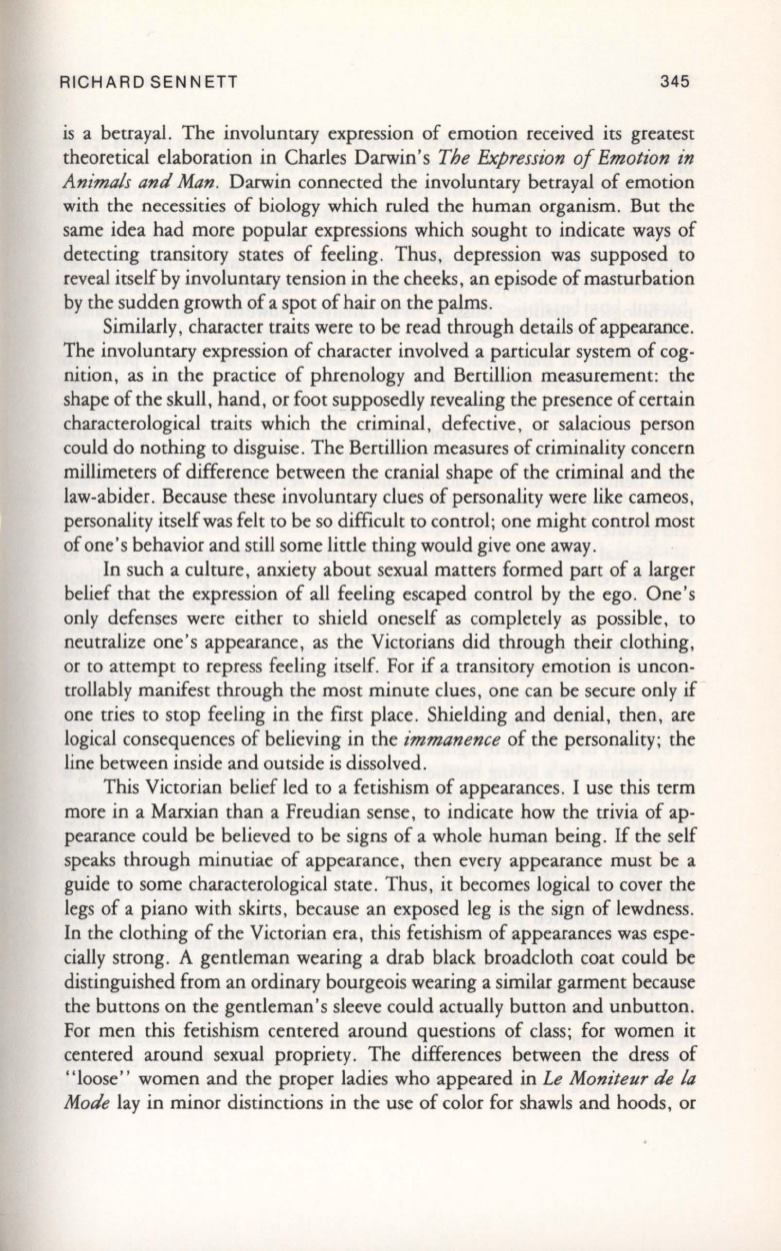
RICHARD SEN N ETT
345
is a betrayal. The involuntary expression of emotion received its greatest
theoretical elaboration in Charles Darwin's
The Expression of Emotion in
Animals and Man.
Darwin connected the involuntary betrayal of emotion
with the necessities of biology which ruled the human organism. But the
same idea had more popular expressions which sought to indicate ways of
detecting transitory states of feeling . Thus, depression was supposed to
reveal itself by involuntary tension in the cheeks, an episode of masturbation
by the sudden growth of a spot of hair on the palms.
Similarly, character traits were to be read through details of appearance.
The involuntary expression of character involved a particular system of cog–
nition, as in the practice of phrenology and Bertillion measurement: the
shape of the skull, hand, or foot supposedly revealing the presence of certain
characterological traits which the criminal, defective, or salacious person
could do nothing to disguise. The Bertillion measures of criminality concern
millimeters of difference between the cranial shape of the criminal and the
law-abider. Because these involuntary clues of personality were like cameos,
personality itself was felt to be so difficult to control; one might control most
of one's behavior and still some little thing would give one away.
In such a culture, anxiety about sexual matters formed part of a larger
belief that the expression of all feeling escaped control by the ego. One's
only defenses were either to shield oneself as completely as possible, to
neutralize one's appearance, as the Victorians did through their clothing,
or to attempt to repress feeling itself. For if a transitory emotion is uncon–
trollably manifest through the most minute clues, one can be secure only if
one tries to stop feeling in the ftrst place . Shielding and denial, then, are
logical consequences of believing in the
immanence
of the personality; the
line between inside and outside is dissolved.
This Victorian belief led to a fetishism of appearances. I use this term
more in a Marxian than a Freudian sense, to indicate how the trivia of ap–
pearance could be believed to be signs of a whole human being. If the self
speaks through minuriae of appearance, then every appearance must be a
guide to some characterological state. Thus, it becomes logical to cover the
legs of a piano with skirts, because an exposed leg is the sign of lewdness.
In the clothing of the Victorian era, this fetishism of appearances was espe–
cially strong. A gentleman wearing a drab black broadcloth coat could be
distinguished from an ordinary bourgeois wearing a similar garment because
the buttons on the gentleman's sleeve could actually button and unbutton.
For men this fetishism centered around questions of class; for women it
centered around sexual propriety. The differences between the dress of
"loose" women and the proper ladies who appeared in
Le Mont"teur de fa
Mode
lay in minor distinctions in the use of color for shawls and hoods, or


